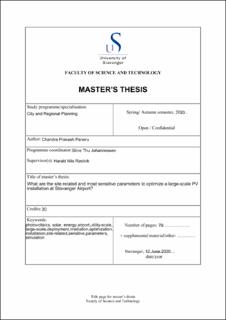| dc.description.abstract | The climate and energy problems are on the rise as the urban population is growing rapidly. The extensive use of fossil fuels and the increasing greenhouse gas (GHG) emissions still awaits collective abatement policies. In this scenario, the need for innovative urban renewable energy solutions is much more crucial than ever.
As Norway envisions to achieve a low carbon society, it mandates abatement measures in all sectors. In the Aviation sector, abatement measures such as renewing of the fleet, electric flights, and use of jet biofuel are potential measures. To achieve 100 per cent electric aviation by 2050, Avinor is exploring innovative local renewable energy solutions at its airports. In the first phase, it plans to install a large-scale PV system of 1000 KWp installed capacity at the preregulated open space inside Stavanger airport. With rapid technology advancement and cost reduction, the photovoltaic (PV) system has gained attention as a potential urban energy solution.
The scale of this thesis is to study the planned first phase PV installation through a research methodology that involves site analysis, test rig analysis, spatial calculations, and simulations. The research aims to determine the most sensitive parameters that need to be optimized to maximize the production from planned large scale installation and draw crucial information that would help the stakeholders to draw critical decisions.
Site analysis examines extra design considerations, available area, energy demand, and solar resources at Stavanger airport. Similarly, test rig analysis explores and compares the technical specification and power performance of the PV modules used in the test rig at the airport. Spatial calculations present the calculations on land area requirements, spatial setup possibilities, and land-use efficiency. Test rig-scale simulations present a comparative study of various setup possibilities. Similarly, large-scale simulations present the comparison between different alternatives and help to visualize the system at the actual site environment.
For a large-scale PV installation, tilt angle, azimuth angle, inter-row spacing, module orientation (portrait vs landscape), and the number of modules alongside the bottom of each row are found to be most sensitive. At Stavanger airport, the optimal values for these sensitive parameters are found as a tilt angle of 45°, azimuth angle of 0 ° (due south), interrow spacing of 17.22m, module oriented portrait and two modules alongside the bottom of each row. For 1000 KWp of a solar PV installation, 5665 m2 of PV generating surface and a total land area of 29615.9 m2 is required. The installation could avoid 496.7 tonnes of CO2 emissions annually. The installation cost of the system approximates $1114648.36 with a Levelized Cost of Energy (LCOE) as 0.68 KWh/$. The thesis links the transferability of methodology and results of this research to various urban spaces and to support newer concepts such as Nearly Zero Energy Buildings (NZEBs) and positive energy districts (PEDs). Current PV policies are limiting the diffusion of PV systems in Norway. Therefore, the need for liberal PV policies is realized. | |
